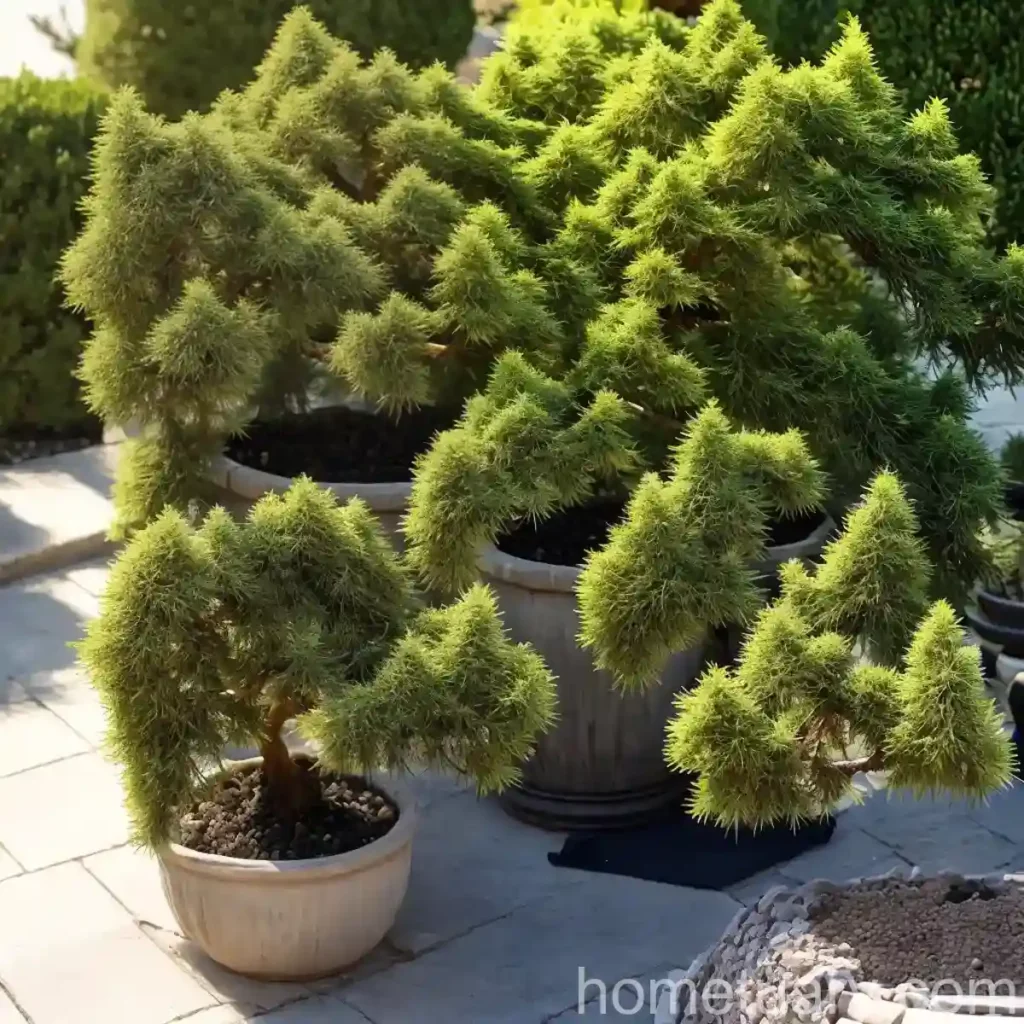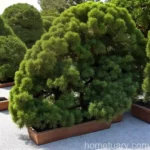All About Chinese Juniper (Juniperus x pfitzeriana ‘Old Gold’)
Plants play a vital role in our ecosystem, offering beauty, oxygen, and numerous other benefits. Among the vast variety of plant species, the Chinese juniper (Juniperus x pfitzeriana ‘Old Gold’) stands out for its unique characteristics and usefulness. In this comprehensive guide, we will explore all aspects of this plant, from its culture and uses to maintenance and care.
What is a Chinese Juniper (Juniperus x pfitzeriana ‘Old Gold’)?
The Chinese juniper, scientifically known as Juniperus x pfitzeriana ‘Old Gold’, is a stunning evergreen shrub that belongs to the family Cupressaceae. This plant is believed to have originated as a hybrid between two other juniper species, namely Juniperus chinensis and Juniperus sabina. Its striking golden foliage and compact growth habit make it a popular choice for landscaping and gardens.
Key Takeaways – Chinese Juniper (Juniperus x pfitzeriana ‘Old Gold’)
Before diving deeper into the specifics of Chinese juniper care and maintenance, let’s outline the key takeaways about this remarkable plant.
- Scientific Name: Juniperus x pfitzeriana ‘Old Gold’
- Common Name: Chinese Juniper
- Family: Cupressaceae
- Foliage Color: Golden yellow
- Growth Habit: Compact and spreading
- Uses: Landscaping, borders, groundcover, and containers
- Maintenance: Low
- Hardiness Zone: 3 to 9
- Sunlight: Full sun
- Watering: Drought-tolerant once established
- Soil: Well-draining, adaptable
- Common Diseases: Canker, blight, and rust
- Common Pests: Aphids, spider mites, and scale insects
With these key takeaways in mind, let’s explore the cultural aspects, uses, and maintenance requirements of the Chinese juniper in detail.
Culture
Understanding the culture and growing conditions essential for the Chinese juniper is crucial to ensure its optimal development and health.
Water
Chinese juniper is known for its impressive drought tolerance once it’s well established. However, during the initial planting and establishment phase, it’s important to provide regular watering to help the plant develop a strong root system. After the plant has matured, it typically thrives in dry to medium moisture levels and can withstand short periods of drought. Overwatering should be avoided, as it can lead to root rot and other issues.
Sunlight
This evergreen shrub thrives in full sunlight, experiencing the best growth and color development when exposed to at least 6 to 8 hours of direct sunlight each day. Insufficient sunlight can result in reduced growth and less vibrant foliage, so it’s important to ensure the plant is placed in a sunny location, especially in cooler climates.
Fertilizer
Chinese juniper is not particularly demanding when it comes to fertilization. However, applying a balanced, slow-release fertilizer in early spring before the new growth emerges can promote healthy development. It’s important to follow the manufacturer’s instructions and to avoid over-fertilizing, as excessive nutrients can damage the plant.
Soil
This versatile shrub exhibits a high level of adaptability to various soil types, thriving in well-draining soils with a wide pH range. Whether the soil is slightly acidic or slightly alkaline, the Chinese juniper generally performs well. However, it’s crucial to ensure that the soil provides good drainage to prevent waterlogging, which can be detrimental to the plant’s health.
Pruning
Pruning is an important aspect of Chinese juniper maintenance, helping to shape the plant, remove dead or diseased branches, and maintain its overall health and appearance. Here are some essential tips for pruning Chinese juniper:
- Prune the plant in early spring before the new growth appears to avoid cutting off new growth.
- Use sharp, clean pruning shears for precise cuts and to minimize the risk of disease spread.
- Remove any dead, damaged, or crossing branches to improve air circulation and encourage healthy growth.
- Shape the plant as desired, keeping in mind its natural growth habit and allowing ample space for its mature size.
Propagation
For those interested in propagating Chinese juniper, there are several methods that can be employed successfully:
- Seeds: Chinese juniper can be propagated from seeds, which should be collected from mature cones and sown in well-draining soil.
- Cuttings: Semi-hardwood cuttings taken in early summer can also be used to propagate new plants. These cuttings should be treated with rooting hormone and planted in a suitable rooting medium.
Both methods of propagation require patience and attention to detail, but they can be rewarding ways to expand your collection of Chinese junipers.
Container Popularity
Due to its compact growth habit and stunning foliage, the Chinese juniper is a popular choice for container planting, whether on patios, balconies, or in gardens. Its adaptability to container cultivation makes it an excellent choice for adding visual interest and color to outdoor spaces.
Common Diseases
Like any plant, Chinese juniper is susceptible to certain diseases that can impact its health and appearance. Some of the common diseases to watch out for include:
- Canker: This fungal disease can cause sunken or swollen areas on the branches, often with discolored or oozing bark.
- Blight: Blight can cause rapid wilting, browning, and dieback of the foliage, often spreading quickly throughout the plant.
- Rust: Rust diseases can lead to orange or yellow rust-like spots on the foliage, potentially causing defoliation if left untreated.
Preventative measures, such as good air circulation, proper watering, and avoiding overhead watering, can help reduce the risk of these diseases affecting your Chinese juniper.
Disease Diagnosis
Diagnosing and addressing diseases in plants can be challenging, but it’s crucial for maintaining the health and vitality of Chinese junipers. When dealing with potential diseases, it’s important to:
- Monitor the Plant: Regularly inspect the foliage, stems, and branches for any signs of discoloration, wilting, or abnormalities.
- Research Symptoms: Educate yourself about common diseases that affect Chinese junipers and familiarize yourself with their symptoms to aid in diagnosis.
- Seek Expert Advice: If you’re unsure about a particular issue, seek guidance from a local horticulturist, plant pathologist, or extension service for accurate diagnosis and treatment recommendations.
Common Pests
Pests can pose a threat to the health and appearance of Chinese junipers, but proactive pest management can help mitigate these risks. Some of the common pests that may target Chinese junipers include:
- Aphids: These small insects can cluster on the foliage, sucking sap and causing distortion or discoloration of the leaves.
- Spider Mites: These tiny pests can cause stippling or webbing on the foliage, leading to reduced plant vigor and health.
- Scale Insects: Scale insects can appear as small, waxy bumps on the stems and foliage, often leading to yellowing or wilting of the plant.
Implementing integrated pest management practices, such as maintaining plant health, promoting natural predators, and using horticultural oils when necessary, can effectively manage pest populations.
Botanist’s Tips
As a botanist specializing in ornamental plants, particularly the Chinese juniper, I’ve gathered some valuable tips for enthusiasts and gardeners who appreciate the beauty and versatility of this species:
- Companion Planting: Pair Chinese junipers with other drought-tolerant plants and ornamental grasses to create visually appealing and low-maintenance landscapes.
- Soil Amendments: When planting Chinese junipers, consider incorporating organic matter into the soil to improve its structure and fertility, contributing to the long-term health of the plants.
- Winter Protection: In regions with harsh winters, provide additional mulch around the base of Chinese junipers to insulate the roots and protect them from extreme temperatures.
By incorporating these tips into your plant care routine, you can enhance the growth and vibrancy of Chinese junipers in your garden or landscape.
Fun Facts
Before we conclude our exploration of the Chinese juniper, let’s delve into some fun and fascinating facts about this plant:
- The golden foliage of Juniperus x pfitzeriana ‘Old Gold’ intensifies in color during the cooler months, adding a warm glow to winter landscapes.
- Chinese juniper is an excellent choice for creating bonsai specimens due to its compact growth habit and striking foliage color.
- The aromatic scent emitted by the foliage of Chinese juniper can add a refreshing and pleasant ambiance to outdoor spaces.
These intriguing facts contribute to the allure of Chinese juniper, making it an appealing addition to a wide range of landscapes and ornamental plantings.
Links to External Resources
For further exploration of Chinese juniper care, landscaping ideas, and maintenance, I recommend the following resources:
- The American Conifer Society – A valuable source of information on conifers, including Chinese junipers and their cultivation.
- University Extension Services – Local extension services provide region-specific guidance on plant care, diseases, and pest management.
With these external resources, you can gain deeper insights into the world of Chinese junipers and expand your knowledge of ornamental plant cultivation.
In conclusion, the Chinese juniper (Juniperus x pfitzeriana ‘Old Gold’) stands as a testament to the beauty and resilience of plant life. Its golden foliage, low maintenance needs, and adaptability make it a sought-after addition to gardens, landscapes, and container plantings. By understanding and implementing proper care practices, enthusiasts can enjoy the striking presence of Chinese junipers in their outdoor spaces for years to come. Whether as a focal point, a border, or a container specimen, this evergreen shrub continues to captivate and inspire plant lovers around the world.















